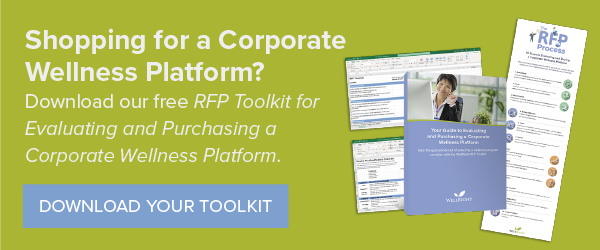
“Our health plan doesn’t offer an effective employee wellness program.”
If your members are saying that about you, first of all, you’re not alone: Many health plans haven’t invested in a wellness platform or programming for their employer groups.
But, there are plenty of reasons why they should.
As it turns out, employee wellness programming can provide a significant advantage to health plans. Let’s look at what stops health plans from offering wellness programs to their employer groups and why those barriers should be overcome.
Common Health Plan Barriers to Offering Employee Wellness Solutions
Small Health Plans Don’t Link Wellness to Revenue
We’ll start with the bottom line—literally. Smaller, regional health plans have a hard time justifying a wellness program offering because it requires resources and capital they don’t think they can spare. Their finance department is going to look at the medical costs and claims liability and ask about the tangible return on investment.
In short, getting buy-in from the CFO of a small health plan is challenging, because the company is already struggling to compete with the larger health insurance providers and needs every dollar in their budget to stay cash positive and ahead of the game.
This barrier is understandable: It’s a tough industry. However, there’s something that this barrier doesn’t consider, which is the effect of a positive customer experience on revenue. Providing a helpful, easy-to-use, accessible offering that improves members’ lives is an easy marketing win for health plans—a rare occurrence in an industry where public perception is a constant challenge.
Larger Health Plans Often Have a Solution (of Sorts) in Place
On the flip side of this coin, large health plans with over a million members have an intricate corporate structure of departments and committees that address population health, disease management, chronic care managers, account management and wellness.
Getting all of those people to agree on a change in direction? It’s not going to be easy, and it’s probably going to take a long time.
Instead, these health plans usually have some sort of wellness solution they’ve built themselves, cobbling together a number of disparate services. They don’t check all the members’ boxes, but many health plans will make do, simply because they’ve already invested the budget and time and don’t wish to make changes (I.e., the sunk cost fallacy).
Then there are the “Frankenstein systems” that we often find when plans undergo a merger or acquisition. In that case, the two health plans come to the table, each with their own wellness programs which are loosely patched together. The result for members? Confusion … and gaps in service.
Either way, large health plans are often reluctant to look for a better solution, because they’re committed to the solution they have—even if it’s less than ideal.
Data Security in Health Care and Wellness Is Essential
Health plans are subject to HIPAA, but there are nuances to a wellness platform that require industry expertise. When you consider that a HIPAA violation can bankrupt a health plan, it’s serious business. That explains why many health plans just won’t attempt to create a wellness program, preferring to err on the side of caution—even if it means missing the benefits a robust wellness program and a dedicated solution provider can offer.
Related Reading: Find out how WellRight transformed Meritain Health’s Wellness Program
How Health Plans Benefit from Employee Wellness Program Solutions
When a small or regional health plan offers a robust wellness platform and program, members are encouraged to use their health benefits for annual physicals and other preventative care.
They receive helpful information about mental health and well-being services that they normally wouldn’t expect from their insurance provider.
They may get financial health information that could help them make better choices about specific health plans and creating budgets.
And they receive support around their occupational well-being.
All of these services are considered “above and beyond” for a health plan to provide. That translates to more renewals and more referrals. Here are a few other ways in which health plans can use an employee wellness program solution to boost their competitive positioning and their revenue:
- Improved Member Engagement: Wellness programs offer a host of channels—text messages, social media, mobile apps, and an easy-to-access platform—through which health plans can communicate with members and provide information that can directly impact wellness. The more engaged members are, the more likely they are to take a more active role in their own health. And as you’re well aware, healthier members typically have fewer claims.
- Better Disease Management: The same goes for disease management programs. Wellness programs facilitate health habits, team challenges and company-wide activities that can motivate members with chronic illnesses or conditions to develop an attainable, enjoyable and effective set of wellness habits.
All these benefits improve member services, which ultimately impacts a health plan’s bottom line.
Related Reading: Top 5 Member Wellness Program Features Health Plans Need to Consider
An Employee Wellness Solution That Covers Service Gaps, Improves Revenue and Protects Sensitive Data
A carefully designed wellness program solution can be a game changer for your health plan organization. Not only can it fill service gaps and delight your members and employer groups, but it can even help you reduce claims and improve population health by providing health plans’ care managers with new and robust tools.
That’s where the right solutions partner can help. At WellRight, we have the technology expertise and an established platform with over 400 wellness activities. Plus, we offer digital mental health solutions that address the mental health crisis in today’s workplace.
Health plans don’t have to abandon what they have; rather, they can work with experts to retrofit their current program into a flexible, scalable platform like the one WellRight offers to deliver on their promise of wellness to their members.
Additionally, health plans have the expertise to apply security levels to their claims platform, but they may not know how to do the same to a wellness platform. By working with an SOC2 type 2 certified provider like WellRight, health plans can have the confidence to know that all of their members’ protected health information is secure.
Learn more about how WellRight can help you drive engagement among health plan members and improve value and retention with your client base.




